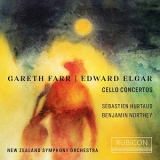 Edward Elgar Cellokonzert op. 85; Gareth Farr: Chemin des Dames; Sébastien Hurtaud, Cello, New Zealand Symphony Orchestra, Benjamin Northey; 1 CD Rubicon RCD1047; Aufnahme 04/2019, Veröffentlichung 11/2020 (59') - Rezension von Remy Franck
Edward Elgar Cellokonzert op. 85; Gareth Farr: Chemin des Dames; Sébastien Hurtaud, Cello, New Zealand Symphony Orchestra, Benjamin Northey; 1 CD Rubicon RCD1047; Aufnahme 04/2019, Veröffentlichung 11/2020 (59') - Rezension von Remy Franck

Drei Großonkel des neuseeländischen Komponisten Gareth Farr (*1968) verloren im Ersten Weltkrieg ihr Leben. Sein Cellokonzert, das der französische Cellist Sébastien Hurtaud auf einer Rubicon-CD spielt, widmete der Komponist denen, die im Ersten Weltkrieg kämpften und auch den Frauen der Gefallenen, die zuhause geblieben waren und mit dem Verlust ihrer Männer, Söhne, Väter oder Brüder leben mussten. Der Titel der Komposition bezieht sich auf den Chemin des Dames, einen Höhenzug im Dreieck der Städte Laon, Soissons und Reims im Norden Frankreichs. Der Name Chemin des Dames, Damenweg, stammt aus der Zeit Ludwig XV., der in dieser Gegend das Jagdschloss Château de la Bôve besaß. Die Töchter des Königs und ihr Gefolge benutzten diesen Weg, wenn sie aus einem der anderen Schlösser nach Bôve fuhren.
Wegen ihrer strategischen Lage war diese Gegend wiederholt Schauplatz von kriegerischen Auseinandersetzungen, u.a. im Ersten Weltkrieg, wo dort eine derblutigsten Schlachten des gesamten Krieges stattfand.
Farrs Werk ist eine Art instrumentales Requiem. Es beginnt wie ein Lamento unter fernem Kriegsgeböller, wird dann unentschlossen bewegter, immer vor einem dunklen Hintergrund. Das Cello, das ständig die Hauptrolle spielt, wird zunehmend nervöser, aber schließlich herrscht dann doch Ruhe und die Musik drückt vor allem Schmerz aus. Ungefähr bei 14 Minuten bricht wieder hektisches Treiben aus, das Cello scheint auf der Flucht zu sein, es kommt zu einem unruhigen Mix von Klage, Ruhe und Kämpfen. Die letzten acht Minuten bestehen größtenteils aus einer Kadenz. Das Cello schildert die Trostlosigkeit eines von Toten und Sterbenden übersäten Schlachtfelds. Dann kehrt zum Abschluss noch einmal unter in der Ferne grollendem Kanonendonner das Lamento zurück. Es überlässt den Zuhörer sich selbst und der Stille. Ein starkes, bewegendes Werk, das in dieser Aufnahme ausdrucksstark und packend gespielt wird!
Vor diesem Cellokonzert ist auf der Rubicon-CD jenes von Edward Elgar zu hören, rund hundert Jahre vor jenem von Farr entstanden. Sébastien Hurtaud und Dirigent Benjamin Northey gehen es sehr sinnlich an und entwickeln dann den ersten Satz zwischen Nachdenklichkeit und leidenschaftlichen Gesten, durchgehend recht düster. Sehr gut gelungen ist der Übergang zum 2. Satz, der nicht auftrumpfend virtuos, sondern eher mit latenter Nervosität gespielt wird. Das melancholische Adagio führt zum Finalsatz, dessen erratische Stimmungswechsel in dieser erregten Darbietung eigentlich nur für totale Ausweglosigkeit stehen können. So gesehen ist dies eine sehr gute und vor alle eine sehr persönliche Interpretation, die im Werk neue Aspekte aufzeigt.
Three great-uncles of the New Zealand composer Gareth Farr (*1968) lost their lives in the First World War. The composer dedicated his Cello Concerto, which the French cellist Sébastien Hurtaud plays on a Rubicon CD, to those who fought in the First World War and also to the wives of the fallen who had stayed at home and had to live with the loss of their husbands, sons, fathers or brothers. The title of the composition refers to the Chemin des Dames, a mountain range in the triangle formed by the cities of Laon, Soissons and Reims in northern France. The name Chemin des Dames comes from the time of Louis XV, who owned a castle named Bôve in this area. The king’s daughters and their entourage used this route when they travelled to Bôve from one of the other royal castles.
Because of its strategic position, this area was repeatedly the scene of armed conflicts, also in the First World War, with one of the bloodiest battles of the entire war.
Farr’s work is kind of an instrumental requiem. It begins like a lament under distant war blasts, then becomes more indecisive, always against a dark background. The cello, which constantly plays the leading role, becomes increasingly nervous, but finally calm prevails and the music expresses above all pain. At about 14 minutes, hectic activity breaks out again, the cello seems to be on the run, and a restless mix of lamentation, silence and struggles ensues. The last eight minutes consist mainly of a cadenza. The cello depicts the desolation of a battlefield with dead and dying soldiers. Then, at the end, the lament returns once more under the thunder of cannons rumbling in the distance. It leaves the listener to himself and the silence. A strong, moving work, which is played expressively and grippingly in this recording!
Prior to this cello concerto, the Rubicon CD features the work of Edward Elgar, written about a hundred years before Farr’s. Sébastien Hurtaud and conductor Benjamin Northey take a very sensual approach and then develop the first movement between thoughtfulness and passionate gestures, quite sombre throughout. The transition to the second movement is very well done and the movement itself is not played with virtuosity, but rather with latent nervousness. The melancholic Adagio leads to the final movement, whose erratic mood changes in this agitated performance can only stand for total hopelessness. So this is a very good and, above all, a very personal interpretation that reveals new aspects in the work.
























